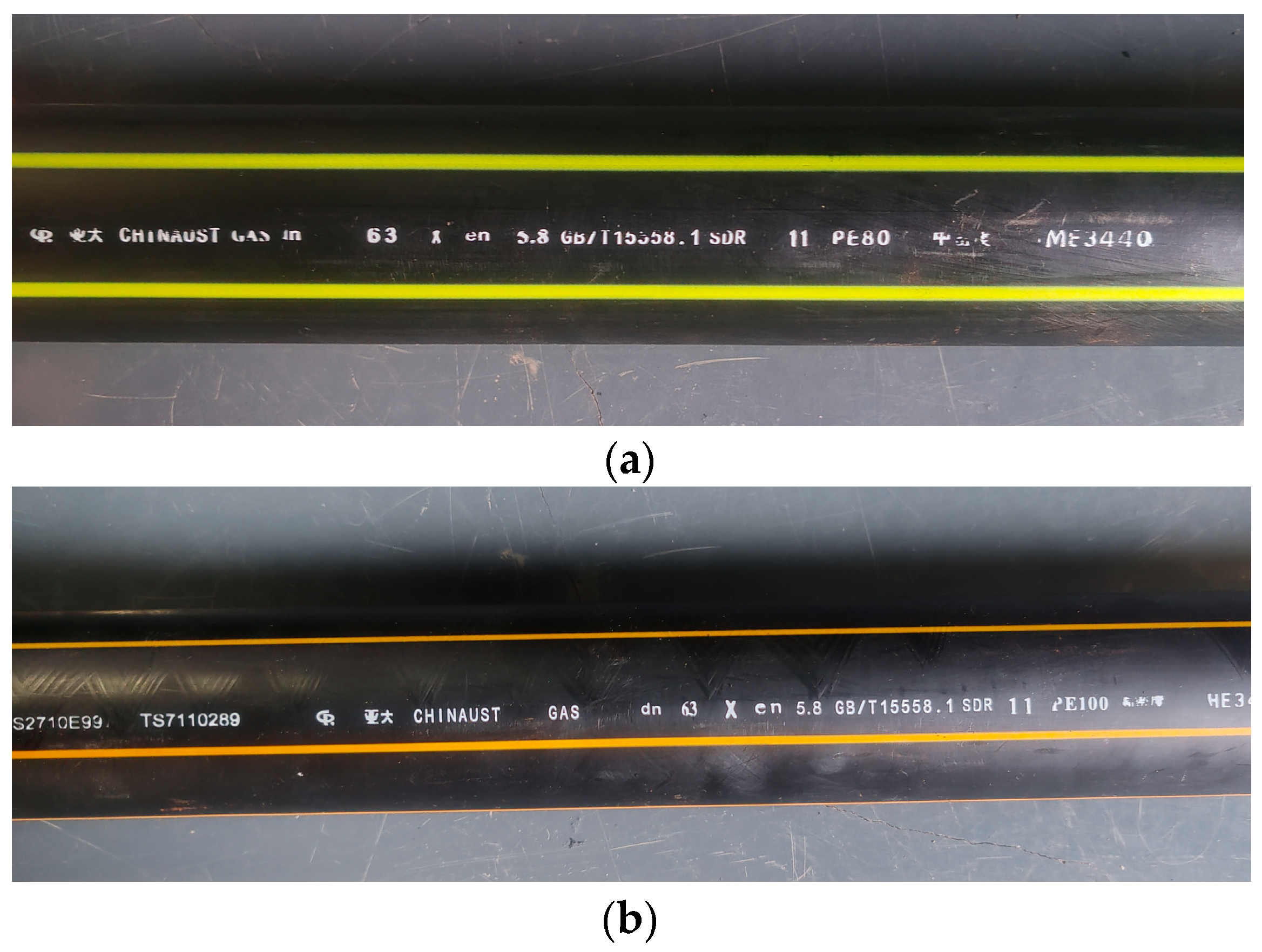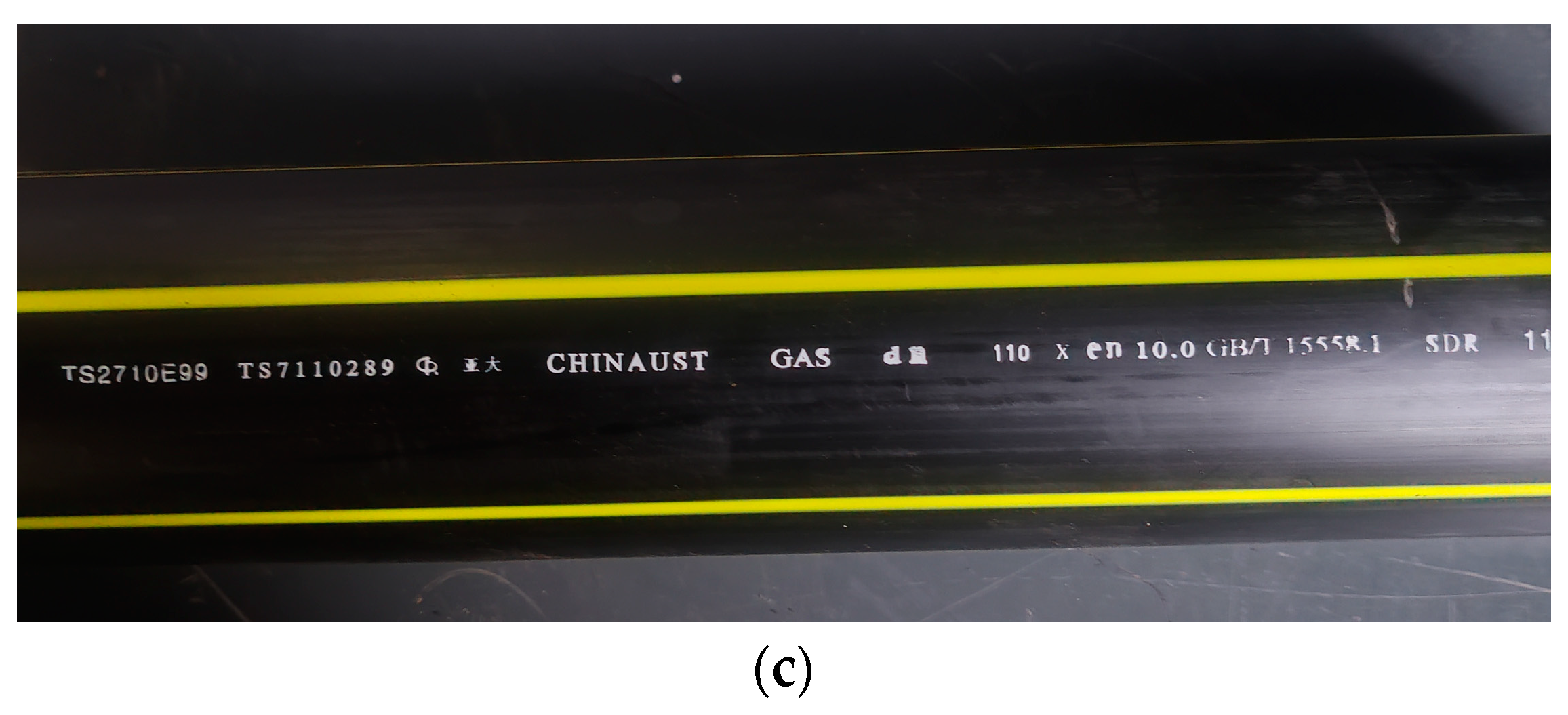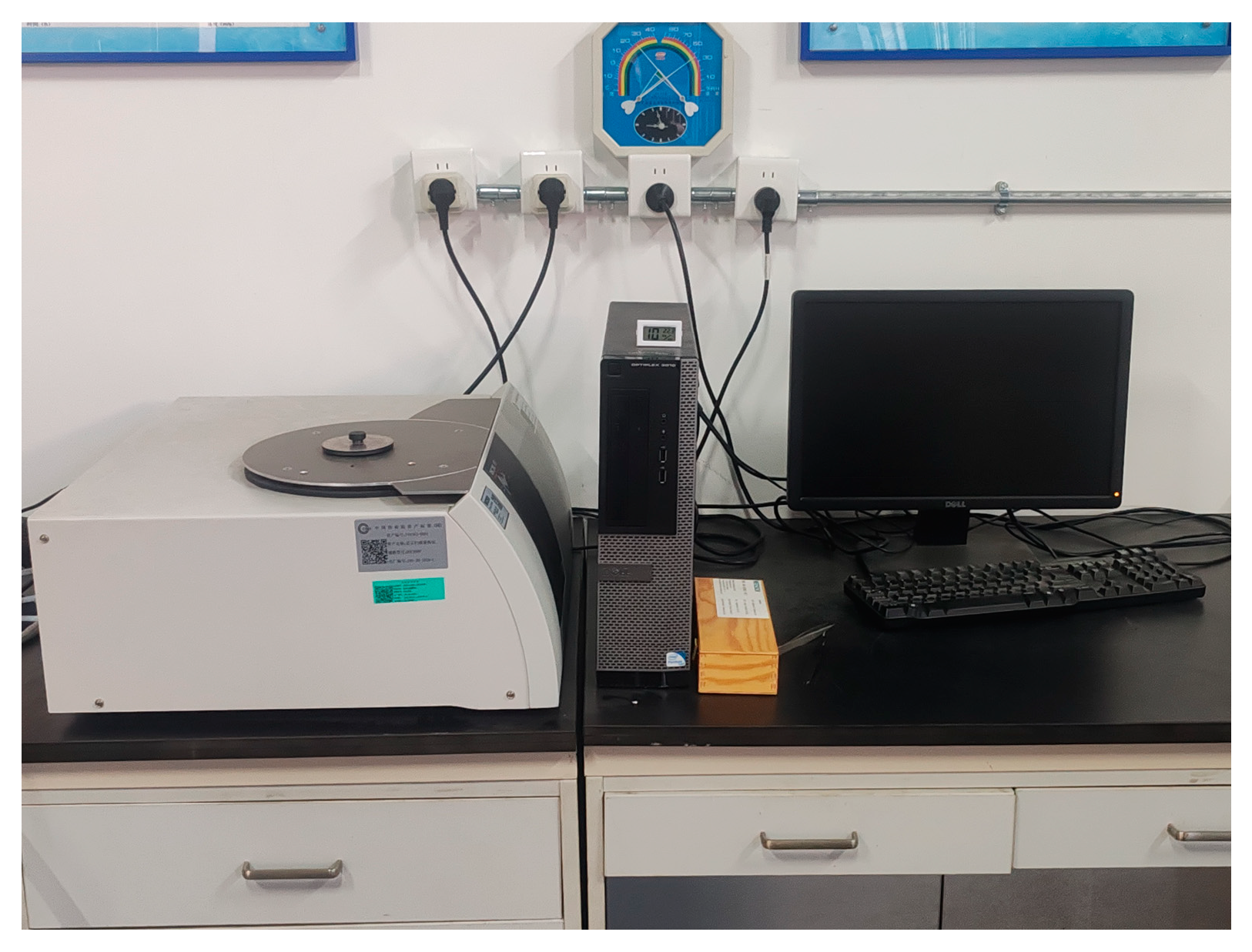Aging Performance and an Improved Evaluation Method for PE80 and PE100 Pipelines for Urban Gas
Abstract
1. Introduction
2. Accelerated Aging Experiment
2.1. Sample Tube Preparation
2.2. Aging Experimental Process
3. The Aging Status of PE Pipes
3.1. OIT Tests
3.2. Results and Comparison
4. Aging Rate Calculation Model
4.1. Aging Rate Calculation Results
4.2. The Modified Calculation Model
5. Conclusions
- The aging experimental results of PE pipes are closer to the actual performance than those obtained from specimens. The aging process can be simulated with different pipe types, diameters, and pressures according to this method. The aging properties of PE pipes can be well characterized by the OIT value of the materials.
- In the aging experiments mentioned in this paper, the effects of pressure, temperature, diameter, and material types on the aging of PE pipes are considered. Based on the Arrhenius formula, the aging reaction rate at room temperature (service temperature) can be calculated under different conditions.
- Comparing the reaction rate coefficients, the diffusion ability of antioxidants in PE pipes enhances as the pressure increases. The antioxidant content is higher in PE pipes with a bigger diameter and wall thickness (when the SRD is constant) and the anti-aging ability is stronger. When the wall thickness doubles, the aging rate decreases about half of the rate under no pressure conditions.
- The anti-aging ability of PE100 is stronger than PE80. The aging life of PE100 is twice as much that of PE80 at room temperature.
- Based on the Arrhenius formula, the evaluation of the aging status can be extended. Combined with the aging experimental results of PE pipes, an improved aging evaluating method considering wall thickness is proposed in this paper, which can be a support for subsequent model improvements.
Author Contributions
Funding
Institutional Review Board Statement
Informed Consent Statement
Data Availability Statement
Conflicts of Interest
References
- Chen, G.-H.; Yang, Y.; Zhou, Z.-H. Research Progress of Polyethylene Pipe Aging Behavior. Polym. Bull. 2018, 31, 35–43. [Google Scholar] [CrossRef]
- Zha, S.; Lan, H.Q.; Huang, H. Review on lifetime predictions of polyethylene pipes: Limitations and trends. Int. J. Press. Vessel. Pip. 2022, 198, 104663. [Google Scholar] [CrossRef]
- Brescia, G. The changing world of the chemical industry and its impact on the pipe industry. In Proceedings of the Plastic Pipes XIV, Budapest, Hungary, 22–24 September 2008. [Google Scholar]
- Andersson, U. Which factors control the lifetime of plastic pipes and how the lifetime can be extrapolated. Book-Inst. Mater. 2017, 59, 311–320. [Google Scholar]
- Lin, N.; Sun, X.; Sun, M.; Cui, W.; Meng, T.; Wang, D. Differentiation of aging properties in different circumferential layers of the polyethylene pipeline. J. Phys. Conf. Ser. 2024, 2783, 01201. [Google Scholar] [CrossRef]
- Zha, S.; Lan, H.Q.; Lin, N.; Meng, T. Degradation and characterization methods for polyethylene gas pipes after natural and accelerated aging. Polym. Degrad. Stab. 2023, 208, 110247. [Google Scholar] [CrossRef]
- Chen, Y.C.; Li, Y.F.; Xi, Y.; Li, Q.; Lu, Q.; Yang, J. Natural aging mechanism of buried polyethylene pipelines during long-term service. Pet. Sci. 2023, 20, 3143–3156. [Google Scholar] [CrossRef]
- Frank, A.; Berger, I.J.; Arbeiter, F.; Pinter, G. Characterization of crack initiation and slow crack growth resistance of PE 100 and PE 100 RC pipe grades with cyclic cracked round bar (CRB) tests. In Proceedings of the 17th Plastic Pipes Conference PPXVII, Chicago, IL, USA, 23–25 September 2014; pp. 22–24. [Google Scholar]
- Nolene, B.; De Silva, R.; Hilditch, T. Linking antioxidant depletion with material properties for polyethylene pipes resins. Polym. Eng. Sci. 2020, 60, 323–329. [Google Scholar]
- Wang, Y.; Lan, H.Q.; Meng, T.; Wang, B.; Guo, D.D.; Zhuang, L.J. Pressure Effects on the Lifetime of Gas High Density Polyethylene Pipes. J. Press. Vessel. Technol. 2021, 144, 021501. [Google Scholar] [CrossRef]
- Yang, W. Research of Lifetime Prediction Method of Urban Gas Polyethylene Pipes by Thermal-Oxidative Aging. Ph.D. Dissertation, Beijing Jiaotong University, Beijing, China, 2019. [Google Scholar]
- Chen, Z.Y.D. Thermal-oxidative aging performance and life prediction of polyethylene pipe under cyclic and constant internal pressure. J. Appl. Polym. Sci. 2019, 136, 27–28. [Google Scholar] [CrossRef]
- Chen, G.; Fang, S.; Yang, Y.; Li, M. Aging Property and Life Prediction of Polyethylene Pipe Under Cyclic Loading. China Plast. Ind. 2022, 008, 050. [Google Scholar]
- ISO 4437-1:2024; Plastics Piping Systems for the Supply of Gaseous Fuels—Polyethylene (PE) Part 1: General. ISO: Geneva, Switzerland, 2024.
- ISO 4437-2:2024; Plastics Piping Systems for the Supply of Gaseous Fuels—Polyethylene (PE) Part 2: Pipes. ISO: Geneva, Switzerland, 2024.
- ISO 4437-3:2024; Plastics Piping Systems for the Supply of Gaseous Fuels—Polyethylene (PE) Part 3: Fittings. ISO: Geneva, Switzerland, 2024.
- ISO 4437-5:2024; Plastics Piping Systems for the Supply of Gaseous Fuels—Polyethylene (PE) Part 5: Fitness for Purpose of the System. ISO: Geneva, Switzerland, 2024.
- Hoàng, E.M.; Lowe, D. Lifetime prediction of a blue PE100 water pipe. Polym. Degrad. Stab. 2008, 93, 1496–1503. [Google Scholar] [CrossRef]
- Bachir-Bey, T.; Belhaneche-Bensemra, N. Investigation of Polyethylene Pipeline Behavior after 30 Years of Use in Gas Distribution Network. J. Mater. Eng. Perform. 2020, 29, 6652–6660. [Google Scholar] [CrossRef]
- GB/T 43922-2024; Inspection and Evaluation of In-Service Polyethylene Gas Pipeline. Chinese Technical Standard: Beijing, China, 2024.
- ISO 11357-6:2018; Plastics—Differential Scanning Calorimetry (DSC)—Part 6: Determination of Oxidation Induction Time (Isothermal OIT) and Oxidation Induction Temperature (Dynamic OIT). ISO: Geneva, Switzerland, 2018.
- ASTM D7444-18a; Standard Practice for Heat and Humidity Aging of Oxidatively Degradable Plastics. ASTM: West Conshohocken, PA, USA, 2018.










| Aging Type | Mechanism | Description |
|---|---|---|
| Photo-oxidative | Photodegradation | The polymer chains will break down under prolonged exposure to ultraviolet (UV) light, causing surface embrittlement and discoloration and impacting resistance reduction. |
| Thermo-oxidative | Chain Scission and Crosslinking | The polymer chains will break or crosslink in an environment with oxygen, which reduces the flexibility and strength of the PE pipe. |
| Stress Cracking | Crack Initiation and Propagation | Micro-cracks on a PE pipe may occur in service, which will grow under mechanical stress. |
| Temp/°C | Pressure/MPa | Aging Times | ||||
|---|---|---|---|---|---|---|
| 1st/h | 2nd/h | 3rd/h | 4th/h | 5th/h | ||
| 80 | 0 | 0 | 144 | 288 | 576 | 864 |
| 0.2 | 0 | 144 | 288 | 576 | 864 | |
| 0.4 | 0 | 144 | 288 | 576 | 864 | |
| 90 | 0 | 0 | 96 | 192 | 288 | 384 |
| 0.2 | 0 | 96 | 192 | 288 | 384 | |
| 0.4 | 0 | 96 | 192 | 288 | 384 | |
| 100 | 0 | 0 | 24 | 48 | 96 | 192 |
| 0.2 | 0 | 24 | 48 | 96 | 192 | |
| 0.4 | 0 | 24 | 48 | 96 | 192 | |
| 110 | 0 | 0 | 8 | 16 | 32 | 72 |
| 0.2 | 0 | 8 | 16 | 32 | 72 | |
| 0.4 | 0 | 8 | 16 | 32 | 72 | |
| Temp/°C | Time/h | OIT/min | ||||||||
|---|---|---|---|---|---|---|---|---|---|---|
| PE80 DN63 | PE100 N63 | PE80 DN110 | ||||||||
| 0 MPa | 0.2 MPa | 0.4 MPa | 0 MPa | 0.2 MPa | 0.4 MPa | 0 MPa | 0.2 MPa | 0.4 MPa | ||
| 80 | 0 | 88.5 | 88.5 | 88.5 | 87.3 | 87.3 | 87.3 | 88.5 | 88.5 | 88.5 |
| 144 | 82.3 | 79.9 | 78.4 | 82 | 79.8 | 79.2 | 84.4 | 84 | 83.9 | |
| 288 | 78.1 | 76.7 | 74.6 | 79.7 | 78.2 | 77.8 | 82.3 | 82.1 | 82 | |
| 576 | 76 | 74 | 71.2 | 78.2 | 75.8 | 74.6 | 80.1 | 80 | 78.1 | |
| 864 | 73.8 | 70.1 | 65.4 | 76.6 | 74 | 71 | 78.9 | 76.8 | 75.4 | |
| 90 | 0 | 88.5 | 88.5 | 88.5 | 87.3 | 87.3 | 87.3 | 88.5 | 88.5 | 88.5 |
| 96 | 81.2 | 80 | 79 | 83.2 | 82.7 | 82.6 | 85.1 | 84.4 | 83.8 | |
| 192 | 80.3 | 78.1 | 75.7 | 82.3 | 78.6 | 77.8 | 83 | 82.5 | 82.2 | |
| 288 | 77.9 | 76.7 | 74.8 | 80.5 | 77.4 | 75.8 | 81.4 | 80.2 | 79.5 | |
| 384 | 76.7 | 74.7 | 73.3 | 77.1 | 74.8 | 72 | 79.4 | 78 | 76.5 | |
| 100 | 0 | 88.5 | 88.5 | 88.5 | 87.3 | 87.3 | 87.3 | 88.5 | 88.5 | 88.5 |
| 24 | 86.1 | 84.3 | 83.3 | 84.8 | 82.8 | 81.9 | 85 | 84.5 | 83.7 | |
| 48 | 83.3 | 82.4 | 79.9 | 82 | 79.2 | 80.3 | 83.8 | 83 | 82.5 | |
| 96 | 80.2 | 77.2 | 76.3 | 79.8 | 77.2 | 77 | 83.2 | 82.3 | 80.5 | |
| 192 | 78.5 | 76.3 | 73.4 | 77.8 | 75 | 73.8 | 81 | 79.4 | 78 | |
| 110 | 0 | 88.5 | 88.5 | 88.5 | 87.3 | 87.3 | 87.3 | 88.5 | 88.5 | 88.5 |
| 8 | 85.8 | 85.6 | 85.4 | 84.6 | 83.9 | 83.6 | 85.6 | 84.7 | 83.9 | |
| 16 | 85.6 | 83.1 | 82 | 83.1 | 81.5 | 80.1 | 85.2 | 84.2 | 83.3 | |
| 32 | 83.5 | 81.9 | 78.6 | 82.2 | 79.8 | 78.5 | 83.5 | 83.4 | 82.3 | |
| 72 | 80.6 | 79.1 | 76.3 | 80.1 | 77.8 | 74.5 | 82 | 80.1 | 78.3 | |
| Pressure/MPa | Temp/°C | K | ||
|---|---|---|---|---|
| PE80 DN63 | PE100 DN63 | PE80 DN110 | ||
| 0 | 110 | 0.00118 | 0.00103 | 0.000911 |
| 100 | 0.0006 | 0.000568 | 0.000385 | |
| 90 | 0.000341 | 0.000293 | 0.000261 | |
| 80 | 0.000191 | 0.000133 | 0.000123 | |
| 0.2 | 110 | 0.0012 | 0.0014 | 0.00116 |
| 100 | 0.000739 | 0.000707 | 0.000478 | |
| 90 | 0.000369 | 0.000391 | 0.000316 | |
| 80 | 0.000212 | 0.000165 | 0.000148 | |
| 0.4 | 110 | 0.00193 | 0.00198 | 0.00142 |
| 100 | 0.000896 | 0.000786 | 0.000567 | |
| 90 | 0.000449 | 0.000491 | 0.000358 | |
| 80 | 0.00031 | 0.000211 | 0.000176 | |
| Pressure/MPa | K | ||
|---|---|---|---|
| PE80 DN63 | PE100 DN63 | PE80 DN110 | |
| 0 | 2.19655 × 106 | 9.02178 × 107 | 1.10495 × 106 |
| 0.2 | 2.48867 × 106 | 9.68853 × 107 | 1.15063 × 106 |
| 0.4 | 2.93855 × 106 | 1.05662 × 106 | 1.21285 × 106 |
| PE80 DN63 | PE80 DN110 | |
|---|---|---|
| en/mm | 5.8 | 10 |
| A | 0.970515076 | 0.981791678 |
| E0/J·mol−1 | 67,611.62464 | 71,869.73828 |
| B | 1,889,022.391 | 5,392,124.386 |
| α | 46.2374 | 107.85093 |
| β | 0.22897 | 0.38765 |
Disclaimer/Publisher’s Note: The statements, opinions and data contained in all publications are solely those of the individual author(s) and contributor(s) and not of MDPI and/or the editor(s). MDPI and/or the editor(s) disclaim responsibility for any injury to people or property resulting from any ideas, methods, instructions or products referred to in the content. |
© 2024 by the authors. Licensee MDPI, Basel, Switzerland. This article is an open access article distributed under the terms and conditions of the Creative Commons Attribution (CC BY) license (https://creativecommons.org/licenses/by/4.0/).
Share and Cite
Lin, N.; Sun, X.; Sun, M.; Li, X.; Liu, C.; Chen, S.; Meng, T. Aging Performance and an Improved Evaluation Method for PE80 and PE100 Pipelines for Urban Gas. Appl. Sci. 2024, 14, 9941. https://doi.org/10.3390/app14219941
Lin N, Sun X, Sun M, Li X, Liu C, Chen S, Meng T. Aging Performance and an Improved Evaluation Method for PE80 and PE100 Pipelines for Urban Gas. Applied Sciences. 2024; 14(21):9941. https://doi.org/10.3390/app14219941
Chicago/Turabian StyleLin, Nan, Xingze Sun, Ming Sun, Xiaolong Li, Changzheng Liu, Shan Chen, and Tao Meng. 2024. "Aging Performance and an Improved Evaluation Method for PE80 and PE100 Pipelines for Urban Gas" Applied Sciences 14, no. 21: 9941. https://doi.org/10.3390/app14219941
APA StyleLin, N., Sun, X., Sun, M., Li, X., Liu, C., Chen, S., & Meng, T. (2024). Aging Performance and an Improved Evaluation Method for PE80 and PE100 Pipelines for Urban Gas. Applied Sciences, 14(21), 9941. https://doi.org/10.3390/app14219941





